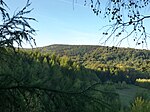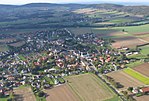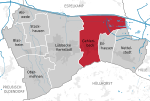Ernst Barre Private Brewery
Beer in GermanyBreweries in GermanyCompanies based in North Rhine-WestphaliaLübbeckeMinden-Lübbecke
The Ernst Barre Private Brewery (German: Privatbrauerei Ernst Barre GmbH) is a brewery in the East Westphalian town of Lübbecke in the north-western German district of Minden-Lübbecke. It was founded by Ernst Johann Barre in 1842. Along with its immediate competitor, the Herforder Brauerei, it is one of the largest breweries in East Westphalia (based on beer production), and is thus of regional importance. The brewery is located at the southern end of the pass over the Wiehen Hills (Bundesstrasse 239) between Lübbecke and Hüllhorst, at the base of the Reineberg hill, and has been in the same family for generations.
Excerpt from the Wikipedia article Ernst Barre Private Brewery (License: CC BY-SA 3.0, Authors).Ernst Barre Private Brewery
Berliner Straße,
Geographical coordinates (GPS) Address Phone number Website External links Nearby Places Show on map
Geographical coordinates (GPS)
| Latitude | Longitude |
|---|---|
| N 52.295069 ° | E 8.618903 ° |
Address
Brauerei Barre
Berliner Straße 122
32312 , Obernfelde
North Rhine-Westphalia, Germany
Open on Google Maps









